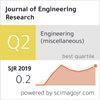研究了翅片数量和构型对双管换热器热液行为的影响
IF 0.9
4区 工程技术
Q3 ENGINEERING, MULTIDISCIPLINARY
引用次数: 0
摘要
目前的研究目标是提高双管换热器(DPHE)的整体性能,同时建立一个预测努塞尔数和摩擦系数的相关方程。利用ANSYS Fluent 2022 R1软件对翅片数量和构型的影响进行了数值分析。研究中考虑的鳍的数量为4、6、8和10,而鳍的配置为纵向和波浪状。为了验证数值计算结果,将传统模型的计算结果与实验结果进行了比较;这一比较表明他们之间非常一致。此外,结果表明,DPHE的整体性能受到翅片数量和配置的影响。结果表明,与传统模型相比,8片波浪鳍结构模型的总体响应为1.33,是所有模型中最优模型。此外,利用数值结果和多元回归分析,建立了四个方程,以预测Nu数和摩擦因数作为雷诺数(Re)、普朗特数(Pr)、翅片数(No. 1)和翼片数(No. 2)的函数。翅片),节距长度(Lp)和内管长度(Lan)。所得Nu数方程和摩擦因数方程对纵翅片的精度分别为98.96%和96.17%,对波浪鳍片的精度分别为99.18%和97.96%。因此,本研究可以准确地描述DPHE的整体反应。本文章由计算机程序翻译,如有差异,请以英文原文为准。
Investigation the influence of the number and configuration of fins on the hydrothermal behavior of a double-pipe heat exchanger
The current study targets improving the overall performance of a Double Pipe Heat Exchanger (DPHE), along with developing a correlation equation to predict the Nusselt number and friction factor. The effect of both the number and configuration of fins has been studied numerically in detail using ANSYS Fluent 2022 R1 software. The numbers of fins considered under study were 4, 6, 8, and 10, while the fin configurations were longitudinal and wavy. To verify the numerical results, a comparison of computational and experimental results was done for the traditional model; this comparison showed excellent agreement between them. Furthermore, the outcomes have shown that the overall performance of a DPHE is influenced by the number and configuration of fins. The results show that the optimum model among all models under study is a wavy fin configuration with 8 fins with an overall response of 1.33 as compared to the traditional model. In addition, four equations were developed using the numerical findings and analysis of multiple regression to predict the Nu number and friction factor as functions of the Reynolds Number (Re), Prandtl Number (Pr), number of fins (No. fin), length of pitch () and inner pipe length (). The accuracy of the Nu number and friction factor equations for the longitudinal fins is 98.96 % and 96.17 %, respectively, while that for the wavy fins is 99.18 % and 97.96 %, respectively. As a result, this study can accurately depict the overall response of a DPHE.
求助全文
通过发布文献求助,成功后即可免费获取论文全文。
去求助
来源期刊

Journal of Engineering Research
ENGINEERING, MULTIDISCIPLINARY-
CiteScore
1.60
自引率
10.00%
发文量
181
审稿时长
20 weeks
期刊介绍:
Journal of Engineering Research (JER) is a international, peer reviewed journal which publishes full length original research papers, reviews, case studies related to all areas of Engineering such as: Civil, Mechanical, Industrial, Electrical, Computer, Chemical, Petroleum, Aerospace, Architectural, Biomedical, Coastal, Environmental, Marine & Ocean, Metallurgical & Materials, software, Surveying, Systems and Manufacturing Engineering. In particular, JER focuses on innovative approaches and methods that contribute to solving the environmental and manufacturing problems, which exist primarily in the Arabian Gulf region and the Middle East countries. Kuwait University used to publish the Journal "Kuwait Journal of Science and Engineering" (ISSN: 1024-8684), which included Science and Engineering articles since 1974. In 2011 the decision was taken to split KJSE into two independent Journals - "Journal of Engineering Research "(JER) and "Kuwait Journal of Science" (KJS).
 求助内容:
求助内容: 应助结果提醒方式:
应助结果提醒方式:


